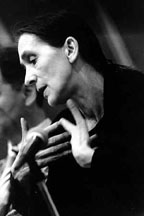|
The Controversial Dance of Pina Bausch
"I loved to dance because I was scared to speak"
— Pina Bausch
When Isadora Duncan first appeared on stage, she shocked or delighted audiences by baring her body and soul in what she called "free dance" Wearing only a simple tunic like the Greek vase figures that inspired many of her dances, she weaved and whirled in flowing natural movements that emanated, she said, from the solar plexus.
At first, music critics, who felt that the dancer had no right to interpret symphonic music, poorly received her performances. The music critic from The New York Times, for example, wrote that there was "much question of the necessity or the possibility of a physical 'interpretation' of the symphony upon the stage...it seems like laying violent hands on a great masterpiece that had better be left alone." (1908). But the audiences grew increasingly enthusiastic, and when Duncan returned to Europe in 1909, she was famous throughout the world and had changed the definitions of dance forever. Duncan was the first American dancer to develop and label a concept of natural breathing, which she identified with the ebb and flow of ocean waves, to define movement based on natural and spiritual laws rather than on formal considerations of geometric space, and to de-emphasise scenery and costumes in favor of a simple stage setting and simple costumes, suggesting that watching a dancer dance was enough.
Moreover, it was Isadora Duncan together with Loie Fuller, Ruth St. Denis, Rudolf von Laban, Mary Wigman and Martha Graham who took dance to a completely different level. Each rebelled against the rigid formalism, artifice, and superficiality of classical academic ballet and against the banality of show- dancing. Each sought to inspire audiences to a new awareness of inner or outer realities, a goal shared by all subsequent modern dancers.
More than any other choreographer of the latter half of 20th century, the dancer and choreographer Pina Bausch (born 1940 in Solingen/Germany), has had the power to 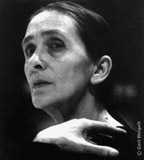 simultaneously mesmerize and repel audiences throughout the world, crossing barriers of language and culture with work grandiose and controversial that probes the dark and eccentric recesses of the mind. During the past 30 years, she has influenced subsequent generations of dancers, choreographers, and thespians throughout the world, including Martha Clarke, William Forsyth, and Robert Wilson. simultaneously mesmerize and repel audiences throughout the world, crossing barriers of language and culture with work grandiose and controversial that probes the dark and eccentric recesses of the mind. During the past 30 years, she has influenced subsequent generations of dancers, choreographers, and thespians throughout the world, including Martha Clarke, William Forsyth, and Robert Wilson.
Bausch's choreography demands that the players abandon themselves right up to the physical limits. It is only this that gives the pieces an authenticity and dramatic power that is transmitted directly to the bodies of the audience. Pain, suffering, desperation are not merely implied or conveyed in a pretty gesture. They are unloaded with the force of extreme physical and emotional presence. This requires dancers who have no fear of themselves and who are prepared to reveal the elementary human drives in them and to portray this authentically on the stage. Gradually, Pina Bausch changed her way of working. She started to ask her dancers questions: the start of broad-based research about the limits and possibilities of communication. Where do we touch ourselves and how do we distance ourselves from each other? Answers were sought for buzzwords: this was no vague improvisation, much rather it required something more precise, a moment of honesty that is only brought into choreographic form when something is really touched. A voyage of discovery - a new one for each piece - starts with this, which believes that every body stores a plethora of behaviours, hopes and desires, fears and lusts, not least possible solutions. An ensemble knows more than a single choreographer can know. The method uses the knowledge stored in every body and brings it into the open. It gives every dancer the scope to discover and display his individual knowledge of the world. It bears witness to a deep respect for each individual who has a right to be there in his uniqueness and distinctiveness.
It is difficult to think of another European dance artist who has continued throughout her career to be as both influential and as controversial as she is. Although Bausch trained in New York for three years from 1959-62 during her formative phase as a young dancer, her sensibility is firmly European in the visions of a dark, brooding and tension-filled world her theatre depicts, most vividly expressed in Bausch's dances in the inhumanity of men and women toward each other and the callous indifference of the world that surrounds them.
Bausch's pieces are multi-layered and studded with curious props, ironic twists, and self-revelatory text, much of which is drawn from the personal life experiences of the performers in her company and their responses to the probing questions Bausch poses during the lengthy rehearsal process.
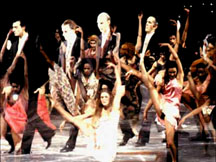 |
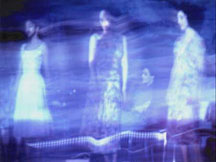 |
Her large and diverse group of performers -- usually 20-plus per show from several different countries -- is costumed in formal eveningwear and often addresses the public directly while engaging in repetitive task-oriented movement. This repetition of simple movements or phrases, which has become a hallmark of Bausch's work, serves to intensify the physical and/or emotional brutality or tenderness inherent within the choreography. Common themes include exploring the dichotomies inherent in relationships between men and women and the individual and the group -- the sinister versus the benign, the comedic versus the tragic, perhaps juxtaposed or layered Felllini-style with seemingly random imagery.
Since the mid-1970s at the latest, Pina Bausch has been faced with the question as to whether what she was doing was really dance - and not theatre: a misunderstanding that expanded her earlier statement that she is less interested in how people move than what moves them. In fact, the choreographer continuously diluted the dance in her pieces over almost two years. But she has never really given up dancing and in her recent pieces dance is once more strongly to the fore, maybe also because the dance passages have proved to be more resistant to time than the spoken parts in the regular repeat performances of her early and mid-career pieces. But ultimately, the question as to whether Pina Bausch's work as a whole and individual pieces of her total of over twenty full-evening pieces should be classified as dance or theatre is irrelevant because everything that her dancers do in her pieces - even the speaking - is incorporated in a great dancing rhythm. 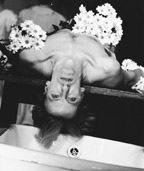 After all, Pina Bausch has only done what all great reformers in dance history have done. By crossing boundaries and pushing them, she has given dance a new dimension: as an art not only of beauty (which is always present in her pieces), but also above all of freedom, full of love, tenderness and humanity. After all, Pina Bausch has only done what all great reformers in dance history have done. By crossing boundaries and pushing them, she has given dance a new dimension: as an art not only of beauty (which is always present in her pieces), but also above all of freedom, full of love, tenderness and humanity.
The new work of Pina Bausch carries the title Ten Chi (Heaven and Earth) and is the Japanese co-production of Pina Bausch on July 6, one week before the production of "Bandoneon" in Shinjuku, a suburb of Japan.
The Tang piece premiered 1980 in Wuppertal and was last performed ten years ago in Buenos Aires and will be a part of the Festival in Wuppertal in October 2004.
The festival (from 1 – 24 October) includes also "For the children of yesterday, today and tomorrow"; the performance Pina Bausch will stage 16/18/21 November this year at the Brooklyn Academy of Music, New York
The show was performed in 2002, and it is a new interpretation of the world of feelings, although on this occasion it focuses on children and the strength of their imagination. "The images make the fantasies of the audience take flight", said the author of the work. Pina Bausch and her company were working on it for two years, and were trying to understand the feelings of children, especially "getting close again to things we have forgotten and thanks to them perhaps being able to understand better the world around us". It is a show to take us back to our own childhood and leave behind fears, and it is about "all aspects of childhood". Pina Bausch found the title in a book of stories about a North American Indian.
Fourteen ballerinas perform this show that has a large repertoire of songs, including a good number of Brazilian ones.
|
